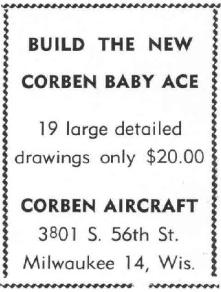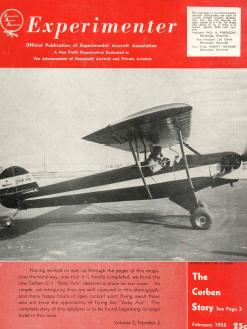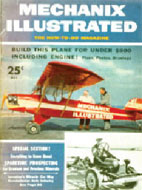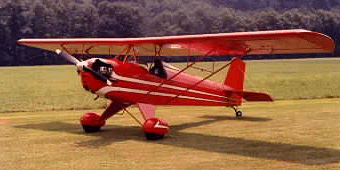
Home | Location | Contact | Donate | Ace Aircraft, Inc.
1950s - Ace Aircraft Start the Homebuilt Movement Again
1950s - Mr. Bob Skuldt, a member of the Light Plane Club of Milwaukee, tells Mr. Paul Poberenzy that the assets of the Corben Sport Plane Company are stored in Shoelkopf's Machine Shop in Madison, WI. Mr. Poberenzy is deployed to Korea shortly thereafter. [1]
January 26, 1953 - The Experimental Aircraft Association (EAA) is founded to support and promote homebuilding.
February 1953 - The first issue of the Experimenter is published by the EAA.
Fall 1953 - After returning from Korea, Mr. Poberenzy goes to Madison, WI and meets with Mr. Shoelkopf. Two hours later, Mr. Poberenzy purchases the spare Corben parts and drawings for the Baby Ace, Junior Ace, and Super Ace for $200. He moves the Corben assets to his hangar and garage. [2]
November 1953 - The Corben Super Ace appears on the front page of Experimenter magazine. [3]
November 1953 - Mr. Poberenzy announces that he acquired the assets of the Corben Sport Plane Company four weeks earlier. It takes two large four-wheel trailers to haul the Corben assets to Milwaukee, WI. [4] Mr. Poberenzy advertises Baby Ace, Junior Ace, and Super Ace plans for sell in the Classifieds section of the Experimenter. The price for a set of plans appears to be $13 per set. [5]

December 1953 - Mr. Poberenzy states he is getting ready to convert his closed-cockpit Junior Ace to an open-cockpit aircraft. The article does not specify whether this Junior Ace was acquired with the Corben Sport Plane Company assets. [6]

January 1954 - The Corben Junior Ace appears on the front page of Experimenter magazine. [7]
March 1954 - Due to the interest shown for the kit version of the Baby Ace, Corben Aircraft decides to build and modernize the Baby Ace design. [8]
1954 - Mr. Poberenzy asks Mr. Stanley J. Dzik to modify and re-engineer the Baby Ace drawings to meet the current CAA standards. The result is the Baby Ace Model C. [9]
May 1954 - Corben Aircraft starts construction of the Baby Ace Model C. They state that if enough interest is shown in the aircraft, Baby Ace kits will be sold. [10]
August 1954 - Mr. Poberenzy updates Corben Aircraft's status on modifying the Baby Ace. It is mentioned that many of the modifications are the inclusion of Piper J-3 Cub parts such as the landing gear, cowling, and fuel tank. While the cost of the Baby Ace kit has not been determined, Corben Aircraft expects the price to be between $900 and $975. [11]
 |
|
| Span - 25 ft. Length - 18 ft. Height - 6 ft. 6 in. |
Empty Weight - 530 lbs. Cruising Speed - 100 m.p.h. Stalling Speed - 30 m.p.h |
November 1954 - Mr. Poberenzy announces that Mr. Stan Dzik has completed the Baby Ace Model C drawings, and the plans are now available for purchase. The Baby Ace Model C plans are advertised for sell in the Classifieds section of the Experimenter. [12] [13]

January 10, 1955 - The Baby Ace Model C-1 makes it maiden flight. [14]
 |
|
| Span - 25 ft. 9 in. Length - 18 ft. Height - 6 ft. 7 in. Fuel Capacity - 12 gals. Wing Area - 112.3 sq. ft. Empty Weight - 569 lbs. Gross Weight - 828 lbs. |
Wing Loading - 6.8 lbs. per sq. ft. Airfoil - Clark Y Maximum Speed - 110 m.p.h. Cruise Speed - 95 m.p.h. Landing Speed - 30 m.p.h. Rate of Climb - 1200 f.p.m. Powerplant - Continental A-65 |
February 1955 - The Baby Ace C-1 appears on the front cover of Experimenter magazine. [15]

April 1955 - Mr. Poberenzy announces that there are 19 Baby Aces being built in the United States and that he plans to modernize the Junior Ace by the summer. [16]
May-July 1955 - Mechanix Illustrated Editor, Mr. John Scherrer, asks Mr. Poberenzy if someone can write an article about how to build an airplane. When no one shows interest, Mr. Poberenzy builds a Baby Ace Model C as a three-part series for the magazine in 1955. [17] As a result, the interest in EAA increases dramatically. Letters start arriving at EAA from “Canada, Australia, New Zealand, Japan, India, Great Britain, Norway, Sweden, Belgium, France, Germany, Italy, Spain, and many others.” [18]


June 1955 - Mr. Poberenzy announces he has started to modernize the Junior Ace. A canopy is planned for the aircraft for winter flying. [19]
June 1955 - Due to the significant demand, the Corben Aircraft Company announces it is reorganizing its production to better meet the demand for Baby Ace kits. [20]
September 1955 - Corben Aircraft Company announces that Baby Ace kits will soon be available. The newly reorganized production will take place in West Bend, WI. The Baby Ace kits will be available in three different Groups. Group I will just include the materials to build a Baby Ace from scratch. Group II will be a semi-fabricated, tack welded kit. Group III will be the most complete kits with a fully welded fuselage and will not require any special tools to build. The Group III price is tentatively set at $1,095. [21]

October 17, 1955 – Corben Aircraft Manufacturing, Inc. is incorporated in West Bend, WI. Mr. Poberenzy and Mr. Roger Teague are incorporators. Mr. Cliff DuCharme is the registered agent. [Articles of Incorporation]
October 1955 - Mr. Poberenzy announces that the officers of the reorganized Corben Aircraft Manufacturing are: Mr. Clifford DuCharme, President; Mr. Carl Walters, Vice President; and Mr. Poberenzy, Secretary-Treasury. [22]
November 1955 - The new Corben Aircraft Manufacturing Company announces that they are setting up their new manufacturing facility. Production of Baby Ace kits will begin on December 1, 1955, and will be in full production by January 1956. The modernized Junior Ace is scheduled to fly in three months, but those wishing to build a Junior Ace can purchase the wing drawings and materials now. Corben Aircraft will also sell supplies to homebuilders and custom cut wing spars. [23]
November 1955 – Due to the work load of the newly founded EAA, Mr. Cliff DuCharme of West Bend, WI succeeds Mr. Poberenzy at the Corben Aircraft Manufacturing Company. Due to demand for a two-place aircraft, the company’s Board of Directors makes the decision to temporarily shift resources from the Baby Ace to focus on the development on the Junior Ace. Mr. Carl Walters, who helped to design the Baby Ace Model C, moves from Milwaukee to West Bend, WI to help develop the Junior Ace. The Junior Ace is a widened version of the Baby Ace and uses the same wings, landing gear, and tail feathers and is intended to be offered in both open or closed cockpit versions. The Junior Ace will be broken into subkits and will be offered on a “Pay As You Build” purchase plan. The price of the Junior Ace has not been determined. [24]
1956 - Mr. Dzik helps to modify and re-engineer the Baby Ace Model C to create the Baby Ace Model D. [25]
April 1956 - Due to a misunderstanding in the March 1956 edition of EAA's Experimenter, an announcement is made that the plans, parts, and kits for the Baby Ace Model C and Model D are still available from Ace Aircraft Company (formerly Corben). [26]
April 3, 1956 – Corben Aircraft Manufacturing, Inc. changes its name to Ace Aircraft Manufacturing, Inc. [Amendment]
October 1956-January 1957 - Mr. Poberenzy publishes plans and construction articles for the Junior Ace as a six-part series in Experimenter. The Junior Ace planes are those from the 1930's with excerpts of the Baby Ace Model C plans included for modernizing the Junior Ace wing struts and attach points. [27]
November 15, 1956 - The prototype of the Baby Ace Model D flies for the first time. [28]

1956 - The cockpit of the Baby Ace Model D is widened to create the two-seat Junior Ace Model E. [28]
January 1957 [Experimenter] Lambert Baby Ace.
January 1958-August 1959 - Mr. Carl Walters re-engineers the Baby Ace Model D. The plans are drawing by Mr. Stan Dzik. [25]
1958 - The Federal Aviation Act of 1958 creates the Federal Aviation Agency.
March 1958 - The current Baby Ace Model D and Junior Ace Model E wings are designed and engineered by Mr. Dzik and Mr. DuCharme. [29]
1959 - The Baby Ace Model D appears for the first time in Jane's All The World's Aircraft's 1959-60 edition. [28]
1959 - Mr. Schoelkopf dies. [30]
1 Jones, M., Experimenter, "A Light Plane Beginning,” January 2003, p. 20
2 Poberenzy, P. The Beginning Years, pp. 274-5
3 Experimenter, November 1953, p. 1
4 Poberenzy, P. "The Home-Builders Corner," Experimenter, November 1953, p. 2
5 Ibid., "Classified Ads," p. 3
6 Poberenzy, P. "The Home Builders Corner," Experimenter, December 1953, p. 2
7 Experimenter, January 1954, p. 1
8
"Interest Shown in Kits," Experimenter, March 1954, p. 1
9 Dzik, S. "'Ace' Corben and the 'Baby Ace' Story," Sport Aviation, August 1965, p. 6
10
"News Notes," Experimenter, May 1954, p. 1
11 Poberenzy, P. "Corben Baby Ace," Experimenter, August 1954, p. 8
12 Poberenzy, P. "The Homebuilders Corner," Experimenter, November 1954, p. 2
13
Ibid., "Classified Ads," p. 11
14 "The Baby Ace....," Experimenter, February 1955, pp. 3-4
15 Experimenter, February 1955, Front Cover
16 "Build a Baby Ace," Experimenter, April 1955, p. 6
17 Mechanix Illustrated, May - July 1955
18 “Mechanix Illustrated Baby Ace,” EAA’s Attic, Sport Aviation, October 2008, p. 128
19 Poberenzy, P. "The Homebuilders Corner," Experimenter, June 1955. p. 2
20
"Corben to Reorganize," Experimenter, June 1955, p. 8
21 Kohn, L. "Corben Kits Available Soon," Experimenter, September 1955, p. 13
22 Poberenzy, P. "The Homebuilders Corner," Experimenter, October 1955, p. 2
23
"Kit Production to Start Soon," Experimenter, November 1955, p. 3
24 “Du Charme Now Heads Corben Co.,” Experimenter, March 1956, pp. 2-3
25 Baby Ace Model D Plans
26
“Baby Ace Kits Will Continue to be Available,” Experimenter, April 1956, p. 12
27 Experimenter, October 1956 – January 1957
28 Jane's All The World's Aircraft, 1959-60, p. 240
29
Ace Aircraft Wing Plans
30 Email from Ann Waidelich of the Dane County Historical Society dated May 1, 2009

MUSEUM
Page last updated: Thursday, November 8, 2012